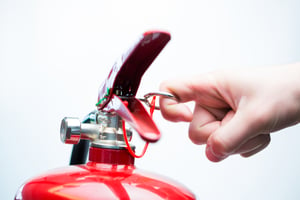
It’s not reasonable to throw bunker gear on Ms. Joan from accounting and have her blast away at a burning target with a 50,000 psi water cannon as a training exercise. Try that in this heat and you can forget receiving her friends and family discount on pecan pie this Thanksgiving. With that said, from the break room kitchen to the treatment plant control room, every member of your organization needs to be primed on the basics of fire prevention and extinguisher use.
Matchmaker, matchmaker
Most extinguishers serve dual purposes and may have multiple classification letters on the label, but Class K  fire extinguishers belong in your computer server room like the guy dressed as a Stormtrooper belongs at The Texas Renaissance Festival. It’s just...wrong. Make sure you’re using the right tool for the job.
fire extinguishers belong in your computer server room like the guy dressed as a Stormtrooper belongs at The Texas Renaissance Festival. It’s just...wrong. Make sure you’re using the right tool for the job.
Class A: Good for ordinary combustibles such as wood and paper.
Class B: Fine for flammables, such as gasoline and oil.
Class C: “C is for Circuitry”- these work on electrically energized equipment.
Class D: Because of their highly specialized use on combustible metals like sodium and magnesium, you can expect to see a five-point star insignia on the label.
Class K: “K is for Kitchen”- these extinguishers contain alkaline mixtures that create a waxy barrier between kitchen grease fires and the surrounding oxygen required to keep them burning. Having one of these handy helps ensure no one ever uses water on a grease fire!
An ounce of prevention
Outside of unique and controlled circumstances, the best fire is the one that never occurs. Use this quick checklist to make sure your workplace remains safe. Add to it with site-specific measures:
- Never block an electrical control panel or access to a fire extinguisher
- Test/inspect smoke detectors, sprinkler systems and extinguishers on a routine basis
- Remove potential fuel sources by managing waste and weeds
- Reference the Safety Data Sheet (SDS) for chemicals you store and ensure they are compatible to be in close proximity; ensure containers and ventilation are correct for the contents
- Smoking should only be allowed in designated areas
- Ensure that tools being used near flammable sources or atmospheres aren’t producing sparks or heat levels that could cause ignition
The list of quick and inexpensive fire prevention tips goes on forever and the sound advice never ends (and they said we couldn’t pull off a risk management Robert Earl Keen reference).
Expect the best, train for the worst
The best training establishes expectations of who is allowed or expected to do what and when. Sounds simple, right? But anyone who has conducted or attended sub-par employee training knows that an instructor can say one thing and the class can soak up a completely different message. Establishing a baseline for employee competency and making sure everyone knows the PASS method (Pull, Aim, Squeeze, Sweep) gives you a firm foundation to build upon.
TMLIRP has been helping Texas municipalities and public entities turn risk-management challenges into victories since 1974. Whether you’re a fire prevention expert or need an extra set of eyes on a new facility, we’re here to help. Contact your loss prevention representative today.



